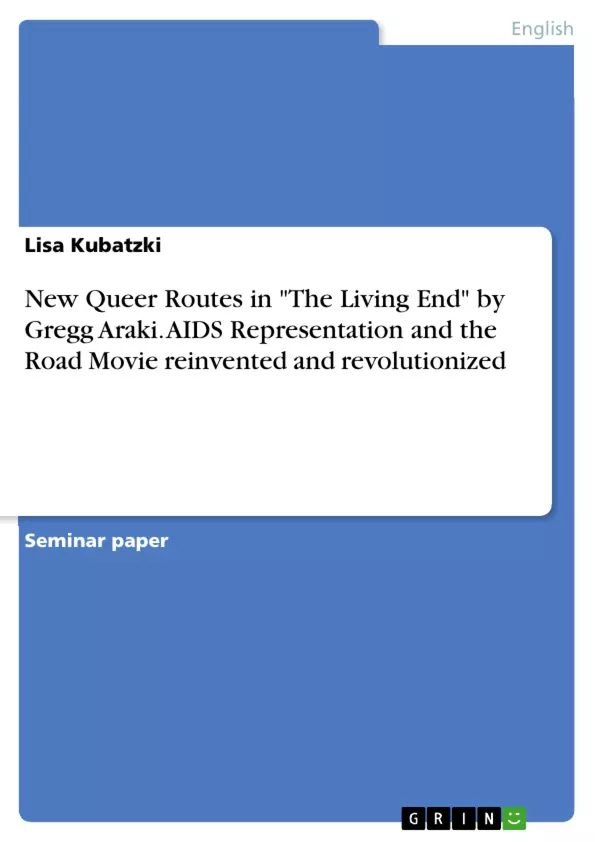In this paper the emerge and characteristics of the New Queer Cinema is elaborated, particularly in the context of the AIDS crisis, as well as on the features of the classical road movie. The focus is mainly on Timothy Corrigan and Ruby Rich's features which they pointed out for each genre, but include many other sources of my findings. After setting the theoretical background for the analysis, a closer look will be made at AIDS representation and road movie features in the movie. It will be furthermore pointed out in which way The Living End queers them, or rather what makes the movie a new queer AIDS road film. The collective pain and resistance of the queer community during the AIDS crisis is fundamental to this queering of the genre(s).
In the 1980s and early 1990s, a wave of fear, desperation and illness rushed over the US American society. The AIDS epidemic gained a foothold among the broad public in the 80s, causing the majority of society to fume and quash the queer community which they held responsible for the spread of the virus. Being under great pressure by this anti-queer attitude on the one side and the dying of masses of infected individuals and the government's ignorance of the AIDS crisis on the other, the community faced a harsh period of struggle, eventually resulting in the uproar of protest and resilience, also in the cinematic sphere.
The New Queer Cinema movement is one outcome of this spirit of resilience whose filmmakers picked parts of movie and narrative conventions and made them queer, inventing new cinematic practices, all in order to fight back and empower the queer community in the times of struggle and crisis. One of the prime example films of that movement is Gregg Araki's The Living End (1992) which marks the fusion and intersection of the much needed overthrew of AIDS representation in media, – offering a queer point of view of life with the epidemic – and the classical road movie genre that the topic of AIDS queers in a typical New Queer Cinema manner. In fact, I claim that AIDS representation in The Living End transforms it into a new sub-genre, the new queer AIDS road film which follows traditions and abstractions of the classical road movie and mainstream AIDS representation of and prior to the 90s.
Inhaltsverzeichnis (Table of Contents)
- Introduction
- New Queer Cinema - Movies made of Queer Collective Resilience
- The 1990s, AIDS Crisis, and the Emerge of New Queer Cinema
- Genre Specific Features
- The US American Road Movie Genre
- Features and Narratives
- Postmodernism & New Routes
- The Living End (1992) - A New Queer AIDS Road Movie
- Representation of AIDS and HIV positive characters
- Queering the Road Movie Genre
- Conclusion
Zielsetzung und Themenschwerpunkte (Objectives and Key Themes)
The paper aims to analyze the impact of AIDS representation in the context of the New Queer Cinema movement, specifically in Gregg Araki's "The Living End" (1992). It examines how the film subverts traditional road movie conventions and AIDS narratives by incorporating a queer perspective.
- The emergence and characteristics of New Queer Cinema in the context of the AIDS crisis
- The features of the classical road movie genre
- The representation of AIDS and HIV positive characters in "The Living End"
- Queering the road movie genre in "The Living End"
- The impact of AIDS activism and protest on queer identity and representation
Zusammenfassung der Kapitel (Chapter Summaries)
- Introduction: This chapter introduces the context of the AIDS crisis in the 1980s and early 1990s, highlighting the fear, desperation, and anti-queer sentiment prevalent in US society. It also introduces Gregg Araki's "The Living End" as a key example of the New Queer Cinema movement and its approach to AIDS representation and the road movie genre.
- New Queer Cinema - Movies made of Queer Collective Resilience: This chapter explores the origins of New Queer Cinema in the context of the AIDS crisis. It discusses how the queer community responded to discrimination and societal hostility, utilizing the term "queer" as a source of empowerment and reclaiming their voices through art and activism.
- The US American Road Movie Genre: This chapter analyzes the key features and narrative conventions of the classical road movie genre, highlighting its recurring themes and motifs.
- The Living End (1992) - A New Queer AIDS Road Movie: This chapter focuses on "The Living End," examining its representation of AIDS and HIV positive characters and how the film queers the road movie genre. It explores the ways in which Araki's film challenges traditional AIDS narratives and offers a new perspective on the crisis.
Schlüsselwörter (Keywords)
The paper focuses on key concepts such as New Queer Cinema, AIDS representation, road movie genre, queer identity, AIDS activism, and the impact of the AIDS crisis on US society.
- Quote paper
- Lisa Kubatzki (Author), 2019, New Queer Routes in "The Living End" by Gregg Araki. AIDS Representation and the Road Movie reinvented and revolutionized, Munich, GRIN Verlag, https://www.grin.com/document/903512



